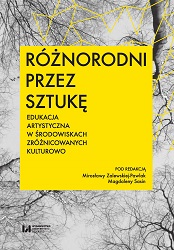Wspólnotowość a indywidualizm w sztuce i wychowaniu estetycznym
Community and Individualism in Art and Aesthetic Education
Author(s): Grzegorz Sztabiński
Subject(s): Fine Arts / Performing Arts, Educational Psychology
Published by: Wydawnictwo Uniwersytetu Łódzkiego
Keywords: art; education; community; Herbert Read; Wolfgang Welsch; Zygmunt Bauman
Summary/Abstract: The starting point for the discussion is Herbert Read’s assertion that education should involve selecting the phenomena of the affecting world, which makes it possible to preserve the community, while allowing individual development of students. Is this position still applicable today, in the era of globalization? The author of the article takes into account two views on the contemporary nature of communities. The first, formulated by Wolfgang Welsch, implies that they should be considered in the transcultural perspective. Japanese culture serves as an example. On the one hand, it values tradition, while the other – it is opening to external elements. Welsch believes that these seemingly contradictory trends are reconciled not in relation to the place of origin, but to the reference and compatibility with what is considered to be one’s own. Accordingly, the attitude to external components is not based on understanding or explanation, but on personal experience and love. Instead of the idea of universalism emphasizing universal similarities (which found expression for example in Andre Malraux’s concept of musee imaginaire), individual experiences are offered that allow one to remain oneself and change at the same time – like water, which is remains the same, although it takes the shape of vessels into which it is poured (Ryūsuke Hashi). The other view examined in the article has been formulated by Zygmunt Bauman. In his opinion, in the case of a true community there is no need for negotiations and compromises, as we do not need to build it and fight for it. It is a “warm circle” (as defined by Goran Rosenberg) that allows a naive immersion in existence. Varieties of social ties found in the world of today (permeated by consumerism) are far from such a sense of community, the concept of which appears as an expression of desire or perceived lack. Given these characteristics of community, the author of the article asserts that the contemporary role of art and aesthetic education has changed. While formerly it was assumed that art serves an integrative purpose, connecting across boundaries, today it realizes differences and seeks possibilities of coexistence. Art is not an area of community, and often becomes an instrument for the establishment of varieties of relationships desired in the broad politics.
Book: Różnorodni przez sztukę. Edukacja artystyczna w środowiskach zróżnicowanych kulturowo
- Page Range: 23-38
- Page Count: 16
- Publication Year: 2017
- Language: Polish
- Content File-PDF

